Xerocomus Quél.
Recent molecular studies have shown that Xerocomus in its current circumscription is likely an artificial grouping and it is possible that it will be split at some point into smaller genera. Molecular studies also have changed our understanding about the species of xerocomoid boletes showing that morphological features are quite variable in this group. Not only microscopic study is essential for determination, but scanning electron microscope will be often needed in this “genus” as the spore ornamentation is not always seen under ordinary light microscope. Do bear in mind that macroscopic characters, such as colours, cracking cuticle, etc., tend to intergrade between the different species. Note that Boletus impolitus and Boletus depilatus that were shown to be close to Xerocomus subtomentosus and its allies, are here retained in Boletus for practical reasons. The same applies also for Phylloporus pelletieri, placed here in a genus of its own, but being also close to Xerocomus subtomentosus group.
Although large reference list will be found under most of the species, one should always consult Ladurner & Simonini (2003) having in mind that there are some new species (X. chrysonemus, X. marekii, X. silwoodensis) described after this otherwise superior book was printed. Useful keys, covering most of the European xerocomoid boletes (except some southern taxa) are provided by Knudsen & Vesterholt (2008), Hills (2008) and Kibby (2011), the later also featuring an excellent comparison chart.
Fruitbody medium to small sized, boletoid, without veil and ring. Stipe solid, often tapering towards the base. Flesh variously coloured, changing or not when exposed to air. Tubes not separable from each other, instead tearing apart. Pores usually angular.
Xerocomus pruinatus Fr. & Hök
Description
Cap up to 10 cm, at first hemispherical, later convex to flattened, ochraceous, light to dark brown, greyish brown, or olivaceous brown, sometimes reddish brown, reddish or almost black, dry, velvety or finely dusted, very rarely cracking and yellowish or whitish flesh is seen in the cracks. Stipe cylindrical to almost club-shaped, sometimes hardly swollen in the lower part, pale yellow or yellow, downwards gradually becoming reddish, covered with scattered fine red granules, blueing when bruised. Tubes pale yellow to yellow, blueing or not when injured. Pores concolorous with the tubes, blueing or not when bruised. Flesh yellowish in the cap, yellow in the stipe, blueing strongly (and usually slowly) when exposed to air. Smell not distinctive. Taste not distinctive. Spores 11–15 × 4.5–6 μm, striate. Pileipellis palisadoderm of septate hyphae of cylindrical, incrusted cells.
Habitat. Mainly in broadleaf or mixed forests, or in parkland, mycorrhizal mostly with beech (Fagus) or rarely with oaks (Quercus).
Distribution. In Europe widespread, but the true distribution is somewhat obscured and is yet to be justified as it might have been confused in the past with the other members around Xerocomus chrysenteron.
Similarity. Xerocomus pruinatus is similar to a number of species, namely:
Xerocomus communis and discoloured forms of X. rubellus – both easily recognized due to the presence of red dots in the flesh in the stipe base and the usually cracked cap surface;
Xercomus bubalinus has dull orange flesh in the stipe base, smooth spores, weakly incrusted hyphae of the cap cuticle and grows with lime (Tilia) or poplars (Populus), mostly in urban areas;
Xerocomus cisalpinus, which also have striate spores grows mostly in warm broadleaf woodlands;
Xerocomus chrysenteron, has cracking cap cuticle with pinkish flesh seen in the cracks and smooth spores.
Photographs
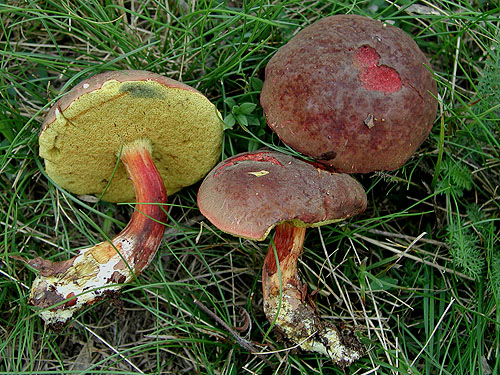
Fruitbodies of Xerocomus pruinatus with reddish brown caps. (photo B. Assyov)

Fruitbodies of Xerocomus pruinatus with dark coloured and uneven cap surface. (photo I. Uhanova)
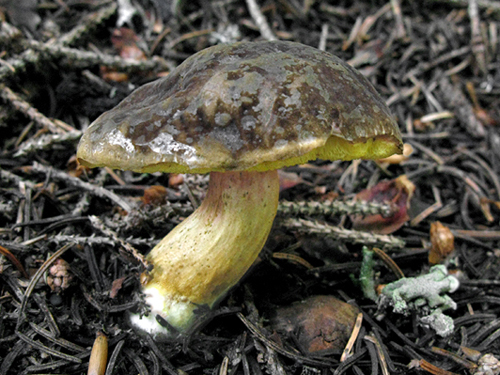
Typically coloured fruitbody of Xerocomus pruinatus. (photo I. Assyova)
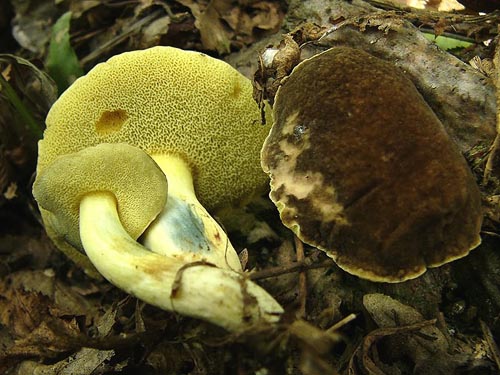
More typical fruitbodies of Xerocomus pruinatus. The stipe is often pale coloured in this species. (photo I. Uhanova)
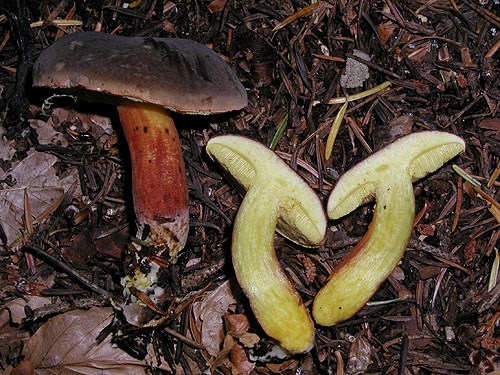
Fruitbodies of Xerocomus pruinatus. Note the yellow flesh, which in this species blues very slowly when exposed to air, the blueing being especially notable in the stipe. (photo B. Assyov)
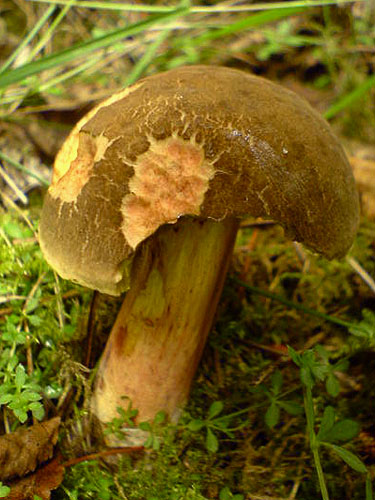
Typically coloured fruitbody of Xerocomus pruinatus. (photo B. Assyov)

Another fruitbody of Xerocomus pruinatus. Note the unusual cracking of the cap surface. (photo B. Assyov)

Close-up of the cap surface of Xerocomus pruinatus. Note the waxy appearence. (photo B. Assyov)
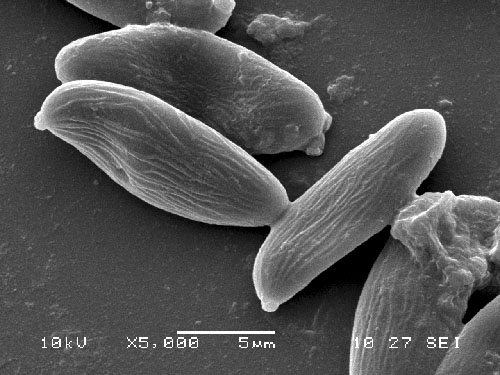
Striate basidiospores in Xerocomus pruinatus under SEM. (photo B. Assyov)
Important literature
Engel, H., Dermek, A., Klofac, W., Ludwig, E. & Brückner, T. 1996. Schmier – und Filzröhrlinge s. l. in Europa. Die Gattungen Boletellus, Boletinus, Phylloporus, Suillus, Xerocomus. Verlag Heinz Engel, Weidhausen b. Coburg.
Hills, A.E. 2008. The genus Xerocomus. A personal view, with a key to the British species. – Field Mycology 9(3): 77–96.
Knudsen, H. & Vesterholt, J. [eds.]. 2008. Funga Nordica. Nordsvamp, Kopenhagen.
Ladurner H. 2001. La variabilità microscopica di Xerocomus pruinatus e la sua delimitazione da specie simili. – Micologia e Vegetazione Mediterranea 16: 46–54.
Ladurner, H. & Simonini, G. 2003. Xerocomus s.l. – In: Fungi Europaei. Vol. 8. Pp. 1–527. Edizioni Candusso, Alassio.
Šutara, J., Mikšík, M. & Janda, V. 2009. Hřibovité houby. Čeled’ Boletaceae a rody Gyrodon, Gyroporus, Boletinus a Suillus. Academia, Praha.
Watling, R. & Hills, A.E. 2005. Boletes and their allies (revised and enlarged edition). – In: Henderson, D.M., Orton, P.D. & Watling, R. [eds]. British Fungus Flora. Agarics and boleti. Vol. 1. Royal Botanic Garden, Edinburgh.